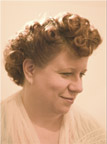
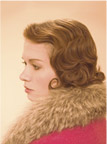
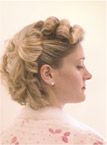
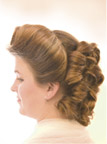
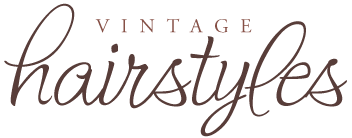
HAIR STYLISTS:
ARDIS ECKEL & KATIE LAZZARINI
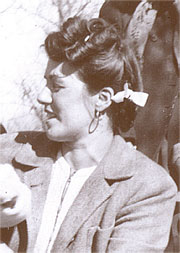 |
|
| above: MaryJane’s aunt, Lois Peterson
opposite: MaryJanesFarm crew (from top) Dory Straight, Sarah Harrison, Amanda Straight, and Taylor Barrett |
“I want this hairdo!” MaryJane exclaimed, handing me a delicate old photo from her family album. It was an image of her Aunt Lois in the ’30s or ’40s, her hair elegantly swept up into graceful rolls atop her head. “Could you do some research on these old hairstyles? Find out how we can do this!”
I couldn’t have been given a better assignment. I’ve been delving into the fashion and style of the ’20s through the ’50s for years. My friends always tell me I was born in the wrong era.
It all started with a love for the music. I’ve loved early jazz and swing music all my life, even if I didn’t know what I was listening to. My high school car was an old ’80s Chevrolet with nothing but an AM radio. I could occasionally tune into a program featuring ’40s music, and I would drive around aimlessly, waiting for the crooners to give way to the more jubilant Andrews Sisters or an occasional upbeat Nat King Cole tune. I didn’t know anything about this music, just that it was old — older than the classic rock my parents grew up with — and definitely different. I knew it was much more complex and intricate than the music I was used to, like a little more care was put into it, a little more thought.
As I became more and more engrossed in early jazz music, I found myself beginning to feel a little nostalgic, somehow, for the old-fashioned lifestyle people used to live. Instead of spending my evenings and weekends watching television shows or playing computer games, I went out dancing to swing bands or old swing records. I learned to dance the dances popular during the swing era. Those dances were so infectiously fun, my nostalgia turned into an obsession for an old-fashioned lifestyle. I wanted to be like the women seen in illustrations in old magazines — innocently perfect hair, makeup, clothes … all dressed up to wash dishes. They made glamour seem everyday, as if it happened naturally. Women just woke up looking elegant.
I occasionally wore skirts, hose and garters to class in college. I powdered my face and wore red lipstick. I attempted the elaborate hairstyles of the swing era … and I found out, at least for me, that these styles didn’t happen naturally. Women didn’t just wake up looking like that — they had to work at it.
In an age where everyone’s hair is “wash and go,” the question you might ask isn’t how women used to do it, but why. Looking through MaryJane’s family photo album, you see the families with young children, outdoors, camping — the women always perfectly coiffed and dressed in fashionable style. You might wonder, with all they had to take care of, why bother with an elaborate hairdo?
People lived in a different culture back then. I think there was a much stronger sense of belonging. People gathered together, danced together and took greater interest in their neighbors’ comings and goings. Taking the extra time to fashion her hair into the style of the day was, perhaps, each woman’s statement of pride in herself as a member of a community she was proud to be a part of.
Nowadays, hair is styled minimally. We use clothes or jewelry to make ourselves look special. Why not use our hair? I can think of nothing more elegant than styling our hair in a way that harkens back to the era of our mothers and grandmothers — back when things took a little more time, and a little more care.